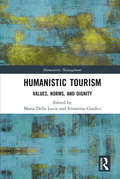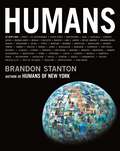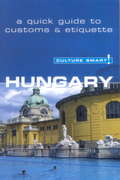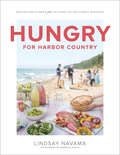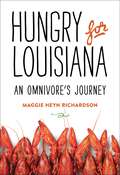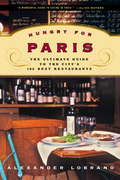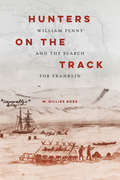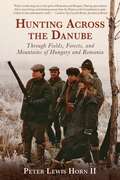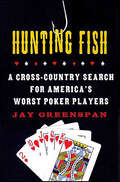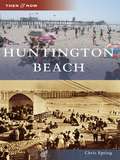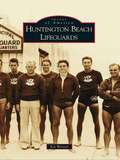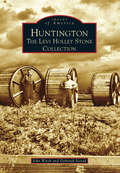- Table View
- List View
Humanistic Perspectives in Hospitality and Tourism, Volume II: CSR and Person-Centred Care (Humanism in Business Series)
by Kemi Ogunyemi Ebele Okoye Omowumi OgunyemiThis book, the second of two volumes, uses a framework of philosophical anthropology, and the concepts of humanistic leadership and humanistic management, to explore the value of work in the hospitality and tourism industry. It presents robust theoretical and practical implications for professionalism and excellence at work.Following on the first volume's focus on the personal dimension of hospitality, this volume explores hospitality from a viewpoint that goes beyond the individual, first situating hospitality within culture, then engaging its internal and external customers and finally integrating issues like vulnerability, sustainability, social responsibility, and industry resilience in the face of the pandemic.These volumes will be of use to academics and practitioners in the fields of hospitality and tourism management, humanistic and transformational leadership, corporate social responsibility, human resource management, customer service, and workplace spirituality.
Humanistic Tourism: Values, Norms and Dignity (Humanistic Management)
by Maria Della Lucia Ernestina GiudiciHuman dignity has experienced limited attention in tourism studies. The interlinked dimensions of dignity in tourism urgently ask for broad avenues of future research, as tourism is both an information-intensive industry and an "experience good" resulting from the relationship and co-creation processes involving hosts and guests in different political, socio-economic, cultural, and environmental contexts. These contexts play a role in how an individual’s values, norms, and experiences may be experienced in tourism. This edited book is one of the first attempts to apply to tourism a humanistic management approach entailing a re-discovery of the value of human life, dignity, and awareness of the ethical dimensions of work. The book develops awareness of the contemporary relevance of the human dignity concept to interpret and manage the weaknesses of traditional approaches to tourism and cope with the challenges and new scenarios, including the current COVID-19 pandemic crisis. It presents ethical values and norms as both foundations and vehicles to dignify tourism stakeholders’ vision and mission (policy, strategies, and practices) as well as people/tourist beliefs, attitudes, and behaviors. It grounds humanistic education as a pervasive mechanism to innovate tourism management contents and practices by offering to different targets new educational and training formats or framing differently traditional ones. Presenting both a critical and a positive approach to tourism management, the diversity of disciplinary approaches, case studies, and examples makes the book attractive to a variety of readers including tourism scholars, researchers, practitioners, and postgraduate students of management and organization disciplines.
Humans, Horses and Events Management
by Katherine Dashper Guðrún Helgadóttir Ingibjörg SigurðardóttirHorses are perhaps the most common non-human animal to feature in planned events, but although there is considerable research on equestrian sport, there is virtually none on equestrian events. This book begins to address this gap, using the National Championships of the Icelandic Horse as an extended case study to explain in depth the process of managing an event, as well as the larger theoretical implications of events management. Drawing on diverse viewpoints and theoretical perspectives, the book draws wider comparisons to connect events management to larger themes in the social sciences, such as human-animal relations; nationalism; place branding; event impacts; event experience; and inclusion and exclusion. The book is a contribution to two fields. In relation to human-animal studies, it focuses on how the Icelandic horse breed is marketed and celebrated through top-tier competition; whereas from an events management perspective, it considers the role of the event in community building, the practical and theoretical aspects of running a sustainable equestrian event, and the issues that arise in multispecies event contexts. This book: - Uniquely draws together events management and human-animal studies. - Is formed from empirical research conducted by a multinational team of events management and tourism researchers. - Uses a single, extended case study to explore a range of themes and issues, both empirically and theoretically. A valuable resource for researchers of events management, human-animal studies and tourism, this book also provides an in-depth look at end-to-end events management for industry professionals.
Humans: Stories (Humans Of New York #2)
by Brandon StantonBrandon Stanton’s new book, Humans—his most moving and compelling book to date—shows us the world. <p><p> Brandon Stanton created Humans of New York in 2010. What began as a photographic census of life in New York City, soon evolved into a storytelling phenomenon. A global audience of millions began following HONY daily. Over the next several years, Stanton broadened his lens to include people from across the world. <p> Traveling to more than forty countries, he conducted interviews across continents, borders, and language barriers. Humans is the definitive catalogue of these travels. The faces and locations will vary from page to page, but the stories will feel deeply familiar. Told with candor and intimacy, Humans will resonate with readers across the globe—providing a portrait of our shared experience. <p> <b>A New York Times Bestseller</b>
Hungary - Culture Smart!
by Brian McleanCulture Smart! provides essential information on attitudes, beliefs and behavior in different countries, ensuring that you arrive at your destination aware of basic manners, common courtesies, and sensitive issues. These concise guides tell you what to expect, how to behave, and how to establish a rapport with your hosts. This inside knowledge will enable you to steer clear of embarrassing gaffes and mistakes, feel confident in unfamiliar situations, and develop trust, friendships, and successful business relationships.Culture Smart! offers illuminating insights into the culture and society of a particular country. It will help you to turn your visit-whether on business or for pleasure-into a memorable and enriching experience. Contents include* customs, values, and traditions* historical, religious, and political background* life at home* leisure, social, and cultural life* eating and drinking* dos, don'ts, and taboos* business practices* communication, spoken and unspoken"Culture Smart has come to the rescue of hapless travellers." Sunday Times Travel"... the perfect introduction to the weird, wonderful and downright odd quirks and customs of various countries." Global Travel"...full of fascinating-as well as common-sense-tips to help you avoid embarrassing faux pas." Observer"...as useful as they are entertaining." Easyjet Magazine"...offer glimpses into the psyche of a faraway world." New York Times
Hungry for Harbor Country: Recipes and Stories from the Coast of Southwest Michigan
by Lindsay NavamaExplore the unique life and flavors of Lake Michigan with this lavishly illustrated volume of seasonal, allergen-friendly recipes and culinary journey stories.Harbor Country has been a favorite vacation spot for generations. In this combination cookbook and travel guide, Lindsay Navama of Third Coast Kitchen takes you on a culinary journey through Southwest Michigan’s tiny towns, freshwater beaches, and rolling countryside. Lindsay’s recipes will transport you straight to Harbor Country, even if you’ve never visited.Hungry for Harbor Country features fifty-six recipes that celebrate the vast variety of the region’s local ingredients—like asparagus in spring, zucchini and cherries in summer, sugar pumpkins and Brussels sprouts in fall. The Seasonal Fire Pit Seafood Feast uses the freshest catch from the Flagship Fish Market and produce sourced from nearby farms.Recipes for regional favorites like the Luisa’s Cafe Blueberry Mascarpone Crepes and the Whistle Stop Aunt Wilma Bar welcome readers into the region’s beloved restaurants and cafes. In addition to celebrating the many occasions for living well at the lake and beyond, many of these recipes are dairy- or gluten-free.
Hungry for Home: A Journey from the Edge of Ireland
by Cole MoretonMoreton delivers this beautiful, haunting, previously untold story of a vanished people from the edge of Ireland and the events that led to the abandonment of their way of life. This book is about home and what that means and a gripping account of the quest for a vanished people. [From the back cover:] "On Christmas Eve, 1946, a young man collapsed on a remote island off the coast of Ireland. There was no priest, no doctor, and no policeman on the Great Blasket, and no contact with the outside world. Helpless, his family watched him die. Cole Moreton's Hungry for Home tells the story of an Irish island, whose inhabitants lived a medieval way of life and spoke a pure form of Irish, until the dramatic events that led to its being abandoned. Searching for the islanders who had left half a century earlier, Moreton seeks out the dead man's brothers and finds them in America. This is a book about home and what that means, but most of all it is a story of a family and their breathtaking journey from one way of life to another." The author tells the story he learned from articles and books, but most importantly from the last islanders themselves. Cole Moreton spent years exploring the remains of the village on the Blasket Island, making land and sea journeys as it's people did, tracing their path to reside on Mainland Ireland and across the Atlantic to the United States. As he visits former islanders, whose children have become quite Americanized, he discovers that the Blasket community reassembled itself in Connecticut in an area they named Hungry Hill. Excerpts of books written by islanders, and accounts of their work, stories, loves and losses are revealing and moving, and as the author admits, often edited by the tellers to cast their former Blasket home and way of life in the best possible light. Here is the story of the crumbling of a centuries old culture. A list of family names, list of illustrations, and a useful bibliography are included.
Hungry for Louisiana: An Omnivore's Journey
by Maggie Heyn RichardsonFood sets the tempo of life in the Bayou State, where people believed in eating locally and seasonally long before it was fashionable. In Hungry for Louisiana: An Omnivore's Journey award-winning journalist Maggie Heyn Richardson takes readers to local farms, meat markets, restaurants, festivals, culinary competitions, and roadside vendors to reveal the love, pride, and cultural importance of Louisiana's traditional and evolving cuisine. Focusing on eight of the state's most emblematic foods-crawfish, jambalaya, snoballs, Creole cream cheese, filé, blood boudin, tamales, and oysters-Richardson provides a fresh look at Louisiana's long culinary history. In addition to concluding each chapter with corresponding recipes, these vignettes not only celebrate local foodways but also acknowledge the complicated dynamic between maintaining local traditions and managing agricultural and social change. From exploring the perilous future of oyster farming along the threatened Gulf Coast to highlighting the rich history of the Spanish-Indian tamale in the quirky north Louisiana town of Zwolle, Richardson's charming and thoughtful narrative shows how deeply food informs the identity of Louisiana's residents.
Hungry for Paris
by Alexander LobranoIf you're passionate about eating well, you couldn't ask for a better travel companion than Alexander Lobrano's charming, friendly, and authoritative Hungry for Paris, the fully revised and updated guide to this renowned culinary scene. Having written about Paris for almost every major food and travel magazine since moving there in 1986, Lobrano shares his personal selection of the city's best restaurants, from bistros featuring the hottest young chefs to the secret spots Parisians love. In lively prose that is not only informative but a pleasure to read, Lobrano reveals the ambience, clientele, history, and most delicious dishes of each establishment--alongside helpful maps and beautiful photographs that will surely whet your appetite for Paris.
Hungry for Paris: The Ultimate Guide to the City's 102 Best Restaurants
by Alexander LobranoIf you're passionate about eating well during your next trip to Paris, you couldn't ask for a better travel companion than Alexander Lobrano's charming, friendly, and authoritative Hungry for Paris, the first new comprehensive guide in many years to the city's restaurant scene. Lobrano, Gourmet magazine's European correspondent, has written for almost every major food and travel magazine since he became an American in Paris in 1986. Here he shares his personal selection of the city's 101 best restaurants, each of which is portrayed in savvy, fun, lively descriptions that are not only indispensable for finding a superb meal but a pleasure to read. Lobrano reveals the hottest young chefs, the coziest bistros, the best buys-including those haute cuisine restaurants that are really worth the money-and the secret places Parisians love most, together with information on the most delicious dishes, ambiance, clientele, and history of each restaurant. A series of delightful essays cover various aspects of dining in Paris, including "Table for One" (how to eat alone), "The Four Seasons" (the best of seasonal eating in Paris), and "Eating the Unspeakable" (learning to eat what you don't think you like). All restaurants are keyed to helpful maps, and the book is seasoned with beautiful photographs by Life magazine photographer Bob Peterson that will only help whet your appetite for tasting Paris.
Hungry: Eating, Road-Tripping, and Risking It All with the Greatest Chef in the World
by Jeff GordinierA food critic chronicles four years spent traveling with René Redzepi, the renowned chef of Noma, in search of the most tantalizing flavors the world has to offer. <P><P> Hungry is a book about not only the hunger for food, but for risk, for reinvention, for creative breakthroughs, and for connection. Feeling stuck in his work and home life, writer Jeff Gordinier happened into a fateful meeting with Danish chef René Redzepi, whose restaurant, Noma, has been called the best in the world. A restless perfectionist, Redzepi was at the top of his game but was looking to tear it all down, to shutter his restaurant and set out for new places, flavors, and recipes. This is the story of the subsequent four years of globe-trotting culinary adventure, with Gordinier joining Redzepi as his Sancho Panza. In the jungle of the Yucatán peninsula, Redzepi and his comrades go off-road in search of the perfect taco. In Sydney, they forage for sea rocket and sandpaper figs in suburban parks and on surf-lashed beaches. On a boat in the Arctic Circle, a lone fisherman guides them to what may or may not be his secret cache of the world’s finest sea urchins. And back in Copenhagen, the quiet canal-lined city where Redzepi started it all, he plans the resurrection of his restaurant on the unlikely site of a garbage-filled lot. Along the way, readers meet Redzepi’s merry band of friends and collaborators, including acclaimed chefs such as Danny Bowien, Kylie Kwong, Rosio Sánchez, David Chang, and Enrique Olvera. <P><P> Hungry is a memoir, a travelogue, a portrait of a chef, and a chronicle of the moment when daredevil cooking became the most exciting and groundbreaking form of artistry.
Hunt for Gold: Sunken Galleons In The New World
by John Christopher FineHunt for Gold: Sunken Galleons in the New World is the engaging tale of the legendary oceanic explorers Bob &“Frogfoot&” Weller and his wife Margaret. The Wellers' lives are a tale of secret treasure hunts, adventurous dives, and underwater explorations, all while laying the foundation for Florida&’s thriving diving community. Combining text with engrossing photos of their underwater voyages and recovered treasures, Hunt for Gold chronicles the contributions of the pioneers of the diving community from the Florida shores and beyond.
Hunters in High Heels
by Omar Rodriguez-LopezInternationally celebrated musician/filmmaker Omar Rodríguez-López presents his first book of photographs, a sublime alternative to traditional rock-and-roll imagery OMAR RODRÍGUEZ-LÓPEZ MAY BE BEST KNOWN for his filmmaking and transcendent songwriting/guitar playing with the Mars Volta, At the Drive-In, and other bands, but many people aren’t aware that he is also an exceptional photographer. Hunters in High Heels is Omar’s first book of photographs, comprising photos taken between 2000 and 2006, during which the sheer scope of output and travel undertaken by the Grammy Award–winning musician and his fellow bandmates was nothing short of exhausting. Sharply juxtaposed with typical books of rock-and-roll imagery, Omar’s photographs—all of which were shot on 35mm film—present a more elusive and evocative aesthetic that includes subjects such as highway signage, city skylines, and cloud formations, along with empty arenas and recording studios with friends and colleagues. This body of work provides an intimate glimpse into a specific period in the artist’s life. In her preface to the book, photo editor Stephanie Celaya writes, “Omar is deeply interested in the world . . . an observer of changing landscapes, shifting cultures, and evolving relationships. Omar’s camera has become his touchstone. The combination of his international recognizability paired with his desire for privacy provides a unique and captivating glimpse into his nomadic life. The irony that Omar Rodríguez-López connects to and captures the quietest moments amid, and in between, some of the loudest places is not lost.” Longtime fans of Omar’s music and film will be regaled with the beauty of these photographs, while newcomers will be feted with the sublime visual treasures comprising Hunters in High Heels.
Hunters on the Track: William Penny and the Search for Franklin
by W. Gillies RossCaptains of whaling vessels were experienced navigators of northern waters, and William Penny was in the vanguard of the whaling fraternity. Leading the first maritime expedition in search of Sir John Franklin, he stood out not just for his skill as a sailor but for his curiosity about northern geography and his willingness to seek out Inuit testimony to map uncharted territory. Hunters on the Track describes and analyzes the efforts made by the Scottish whaling master to locate Franklin's missing expedition. Bookended by an account of Penny's whaling career, including the rediscovery of Cumberland Sound, which would play a vital role in British whaling a decade later, W. Gillies Ross provides an in-depth history of the first Franklin searches. He reconstructs the brief but frenetic period when the English-speaking world was preoccupied with locating Franklin, but when the means of that search – the ships chosen, the route taken, the evidence of Franklin's traces – were contested and uncertain. Ross details the particularities of each search at a time when no fewer than eight ships comprising four search expeditions were attempting to find Franklin's tracks. Reconstructing events, relationships, and decisions, he focuses on the work of Penny as commander of HMS Lady Franklin and Sophia, while also outlining the events of other expeditions and interactions among the officers and crews. William Penny is respected as one of the most influential and innovative figures in British Arctic whaling history, but his brief role in the Franklin expedition is less known. Using primary sources, notably private journals from each of the expeditions, Hunters on the Track places him at the forefront of a critical chapter of maritime history and the geographical exploration that began after Franklin disappeared.
Hunting Across the Danube: Through Fields, Forests, and Mountains of Hungary and Romania
by Peter Lewis Horn IIThis is the first book written in English about two of Eastern Europe's premier hunting destinations. The book is animated by the author's desire to share this little-known sporting paradise with educated hunters. The chapters detail game he has hunted over the past three decades, including stag, boar, roebuck, bear, wolf, chamois, capercaillie, pheasants, mouflon sheep, and ducks in areas that regularly produce world-class trophies and yet remain unknown to even the most experienced hunters. The hunting culture and traditions of Romania and Hungary, which figured so prominently in the Austro-Hungarian Empire, profoundly influenced the development of European, and international, hunting. By sharing the latest facts about the finest hunting areas, hunting seasons, and firearms and equipment, the author hopes to awaken an appreciation for all the best that Hungary and Romania offer sportsmen.
Hunting Fish: A Cross-Country Search for America's Worst Poker Players
by Jay GreenspanIf you want to prove you're a good poker player, you don't have to battle against the best. Nobody really cares if you ever bluffed Phil Ivey or got Daniel Negreanu to make a bad call. You're at the table for the money, not stories of conquest. A disciplined player, one who's playing for the right reasons, would rather sit with the worst, those he's sure to outplay. He's looking for donkeys and donors. He's hunting fish.In Hunting Fish author Jay Greenspan sets out on a cross-country drive---from Connecticut to Los Angeles---looking for players he can outclass. In casinos, underground clubs, and home games throughout the country, Jay shared tables with the most inept gamblers America has to offer. In South Carolina he wiped out some racial-epithet-spewing good ole boys; in Houston he fleeced the country club set; and in Vegas he happily pounded drunken tourists.Hunting Fish is, however, not merely the story of a hustler's travels. In addition to fleecing suckers, Jay was convinced he could beat the very best and make it as a full-time pro. This trip gave him the opportunity to build his bankroll to the point where he could test his mettle in high-stakes games when he reached Los Angeles. Although to play in the high-limit rooms at Commerce Casino he needed a steady nerve---and a fatter bankroll. In his three months on the road, he needed to pad his roll with an additional twenty thousand dollars. That's a lot of fish to hunt.
Hunting Mister Heartbreak
by Jonathan RabanA New York Times Notable Book"In an era of jet tourism, [Jonathan Raban] remains a traveler-adventurer in the tradition of . . . Robert Louis Stevenson." --The New York Times Book Review In 1782 an immigrant with the high-toned name J. Hector St. John de Crèvecoeur--"Heartbreak" in English--wrote a pioneering account of one European's transformation into an American. Some two hundred years later Jonathan Raban, winner of the National Book Critics Circle Award, arrived in Crèvecoeur's wake to see how America has paid off for succeeding generations of newcomers. The result is an exhilarating, often deliciously funny book that is at once a travelogue, a social history, and a love letter to the United States. In the course of Hunting Mr. Heartbreak, Raban passes for homeless in New York and tries to pass for a good ol' boy in Alabama (which entails "renting" an elderly black lab). He sees the Protestant work ethic perfected by Korean immigrants in Seattle--one of whom celebrates her new home as "So big! So green! So wide-wide-wide!"--and repudiated by the lowlife of Key West. And on every page of this peerlessly observant work, Raban makes us experience America with wonder, humor, and an unblinking eye for its contradictions. "Raban delivers himself of some of the most memorable prose ever written about urban America." --Henry Kisor, Chicago Sun-Times"When Raban describes America and Americans, he is unfailingly witty and entertaining." --Salman RushdieFrom the Trade Paperback edition.
Hunting and Fishing the Chesapeake: Unforgettable Tales of Wing and Water
by C. L. MarshallFish and fowl make their way to the Chesapeake Bay with the changing seasons, and sportsmen yearn for the hunt. Whether on the wing or water, stories of the chase are integral to life on the Eastern Shore. Thousands of fishermen turn out for the annual White Marlin Open, but not every boat comes close to winning the tournament’s big money. Dedicated hunters brave the Bay on a cold January day to hunt waterfowl on the Pocomoke Sound. Only the most committed fishermen launch a brand-new boat from Saxis Island in the teeth of a summer storm. Join author C.L. Marshall as he weaves humorous and harrowing tales of the sporting life on the Eastern Shore of the Chesapeake.
Huntington (Images of America)
by Todd Martin Jeffrey WebbEarly pioneers established Huntington in the 1830s at the site where Miami Indians and French trappers exchanged goods. Because of its location near the Historic Forks of the Wabash, Huntington served as an important transportation hub in the Old Northwest. The Wabash & Erie Canal introduced a wide variety of craftsmen and their families to the area until railroads eventually made canal travel obsolete. After the canal boom and bust, railroads and farming dominated Huntington's economy, but textiles, light manufacturing, and limestone quarries populated the landscape; limestone from Indiana was used to build the Washington Monument in Washington, DC. Some residents went on to achieve national fame, including Congressman Ed Roush, the architect of the 911 emergency response system, and Vice Pres. Dan Quayle. The town is also home to Huntington University, a perennial selection as one of the Midwest's best private colleges.
Huntington (Postcard History Series)
by Patricia J. NovakThe town of Huntington has a documented history that dates back to its founding in 1653. The harbors were principally involved in shipping and shipbuilding, and the lush land was ideal for agriculture. When the railroad arrived in the 1860s and then later the automobile, Huntington, part of the Gold Coast of Long Island, became a destination for city residents looking for an escape to fresh air, beaches, and comfortable surroundings. Stately mansions were built, and the villages bustled with new businesses, entertainment, and architecture. That era has been captured in the postcards sent and collected during that time, adding to the social history of Huntington.
Huntington Beach
by Chris EptingThe 100-year history of Huntington Beach is a rich amalgam of agriculture, oil, surfing, beach culture, aerospace, and small-town America. This comparative, visual evolution of the city is crafted for both locals and tourists alike, featuring some of the most defining views ever captured of Surf City, USA®.
Huntington Beach Lifeguards
by Kai WeisserThe Surf City USA® lifeguards and marine safety officers protect and serve one of the busiest and most famous beaches in the world. World-class surfing events, volleyball tournaments, and other activities transform Huntington Beach's waterfront into a sea of humanity regularly each summer. The lifeguards patrol three and a half miles of beautiful wide, sandy Orange County shores, which can draw more than 10 million annual visitors, necessitating as many as 3,000 rescues. The ultimate lifeguard sentinel and guardian is the iconic structure on the HB Municipal Pier called Tower Zero, known as "The Eye in the Sky," from which lifeguards can see for miles. These vintage photographs include shots of the pier, beach, junior lifeguard activities, competitions, and neighboring Huntington State Beach. Thousands of people and families owe gratitude to the lifeguards of Huntington Beach for nearly a century of vigilance, dedication, and service.
Huntington Beach, California
by Chris EptingIncorporated in 1909, Huntington Beach remained a sleepy seaside town until the city's legendary oil boom in the 1920s. Wells sprang up overnight, and in less than a month, the city's population more than doubled. As the area developed culturally through the decades, the once tiny farming community increased its size with 25 miles of annexations to become one of Southern California's major tourist destinations. Pictured here in nearly 200 vintage photographs is the evolution of this small seaside village into a classic, Southern California beach city, known as Surf City to nearly a million tourists a year. Showcased here are images acquired from city records, including shots of the famous Huntington Beach Pier as it evolved over the century, rare amateur photos of one of the largest gushers in city history, vintage beach scenes, rarely seen historic aerial views, images of the turn of the century "Tent City," the infamous flood of 1938, and nostalgic shots of the Saltwater Plunge.
Huntington: The Levi Holley Stone Collection
by John Witek Deborah NovakA flea market discovery that became an art museum sensation, this collection of photographs by Levi Holley Stone presents the city of Huntington, West Virginia, as it has never seen before. Stone's lens reveals a city of contrasts: a blend of broad boulevards and crumbling alleys, a mix of monuments and mud. It is a place where cars share the road with horses, roughnecks loiter in pool halls, and theatergoers enjoy extravagant musicals direct from Broadway. Newcomers flocked to this commercial hub on the Ohio River, and Stone's images of steamboats, trains, and motorcars show how they traveled. He captured the river, too, when it was frozen enough to walk across and furious enough to drown the city more than once. Stone was born in Huntington in 1898, and he photographed his hometown obsessively. Even his closest friends never knew that the photographs they took for granted were sensitive works of art.
Huntley (Images of America)
by Nancy S. BachellerHuntley was founded in 1851. Its first boom years--the 1850s to 1920s--saw the town prosper thanks to the local dairy industry. Prolific dairy farmers provided milk for the many local condensing plants and cheese factories and sent huge surpluses into Chicago by train each day. It was said that the Huntley area produced more milk per square mile than anywhere else in the world. Businesses, homes, and churches all grew with the population. Village founders, movers and shakers of a century and more ago, as well as everyday workers and village residents are captured here in vintage images, showing what life was like in Huntley in years gone by.

